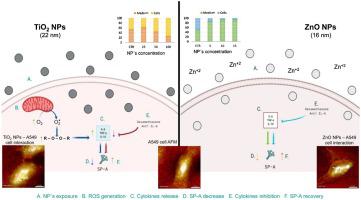Environmental Toxicology and Pharmacology ( IF 4.3 ) Pub Date : 2021-04-03 , DOI: 10.1016/j.etap.2021.103654 A Jiménez-Chávez 1 , A Solorio-Rodríguez 2 , V Escamilla-Rivera 3 , D Leseman 4 , R Morales-Rubio 1 , M Uribe-Ramírez 1 , L Campos-Villegas 5 , I E Medina-Ramírez 6 , L Arreola-Mendoza 5 , F R Cassee 4 , A De Vizcaya-Ruiz 1

|
The increasing use of metal oxide nanoparticles (MONPs) as TiO2 NPs or ZnO NPs has led to environmental release and human exposure. The respiratory system, effects on lamellar bodies and surfactant protein A (SP-A) of pneumocytes, can be importantly affected. Exposure of human alveolar epithelial cells (A549) induced differential responses; a higher persistence of TiO2 in cell surface and uptake (measured by Atomic Force Microscopy) and sustained inflammatory response (by means of TNF-α, IL-10, and IL-6 release) and ROS generation were observed, whereas ZnO showed a modest response and low numbers in cell surface. A reduction in SP-A levels at 24 h of exposure to TiO2 NPs (concentration-dependent) or ZnO NPs (the higher concentration) was also observed, reversed by blocking the inflammatory response (by the inhibition of IL-6). Loss of SP-A represents a relevant target of MONPs-induced inflammatory response that could contribute to cellular damage and loss of lung function.
中文翻译:

TiO2 NPs 或 ZnO NPs 暴露后人肺泡上皮细胞的炎症反应:抑制表面活性蛋白 A 表达作为肺功能丧失的指标
越来越多地使用金属氧化物纳米粒子 (MONPs) 作为 TiO 2 NPs 或 ZnO NPs 导致环境释放和人类暴露。呼吸系统、对肺细胞的层状体和表面活性蛋白 A (SP-A) 的影响可能会受到重要影响。暴露于人肺泡上皮细胞 (A549) 诱导差异反应;观察到 TiO 2在细胞表面的持久性和吸收(通过原子力显微镜测量)和持续的炎症反应(通过 TNF-α、IL-10 和 IL-6 释放)和 ROS 生成,而 ZnO 显示出适度的反应和细胞表面的低数量。暴露于 TiO 2 24 小时时 SP-A 水平降低还观察到 NPs(浓度依赖性)或 ZnO NPs(较高浓度),通过阻断炎症反应(通过抑制 IL-6)来逆转。SP-A 的缺失代表 MONPs 诱导的炎症反应的相关靶点,可能导致细胞损伤和肺功能丧失。



























 京公网安备 11010802027423号
京公网安备 11010802027423号